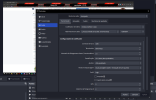Good afternoon.
I've always streamed on my old computer.
However, today my new computer arrived, and I installed OBS again.
It turns out that when I start streaming, the whole stream jams, I'm playing perfectly, but the whole stream is jammed.
The PC is very good, I don't see any reason why this should happen.
_______________________________________________________________
MAIN PC
_______________________________________________________________
MOTHERBOARD: - ASUS ROG Maximus Z790 Dark Hero
PSU: - Seasonic Netzteil Vertex PX 1200 W
PROCESSOR: - Intel CPU Core i9-14900KF 2.4 GHz
RAM MEMORY: - Corsair DDR5-RAM Dominator Platinum RGB 6600 MHz 64GB
WATERCOOLER: - Corsair iCUE H170i Elite LCD XT 420mm
CASE: - Corsair PC-Gehäuse iCUE 7000X RGB Schwarz
GRAPHIC CARD: - Asus ROG Strix GeForce RTX 4090 24GB GDDR6X OC Edition
SSD DRIVES:
Samsung 990 PRO 1TB SSD NVMe M.2
Samsung 990 PRO 1TB SSD NVMe M.2
Attached are the logs and my settings
I've always streamed on my old computer.
However, today my new computer arrived, and I installed OBS again.
It turns out that when I start streaming, the whole stream jams, I'm playing perfectly, but the whole stream is jammed.
The PC is very good, I don't see any reason why this should happen.
_______________________________________________________________
MAIN PC
_______________________________________________________________
MOTHERBOARD: - ASUS ROG Maximus Z790 Dark Hero
PSU: - Seasonic Netzteil Vertex PX 1200 W
PROCESSOR: - Intel CPU Core i9-14900KF 2.4 GHz
RAM MEMORY: - Corsair DDR5-RAM Dominator Platinum RGB 6600 MHz 64GB
WATERCOOLER: - Corsair iCUE H170i Elite LCD XT 420mm
CASE: - Corsair PC-Gehäuse iCUE 7000X RGB Schwarz
GRAPHIC CARD: - Asus ROG Strix GeForce RTX 4090 24GB GDDR6X OC Edition
SSD DRIVES:
Samsung 990 PRO 1TB SSD NVMe M.2
Samsung 990 PRO 1TB SSD NVMe M.2
Attached are the logs and my settings
